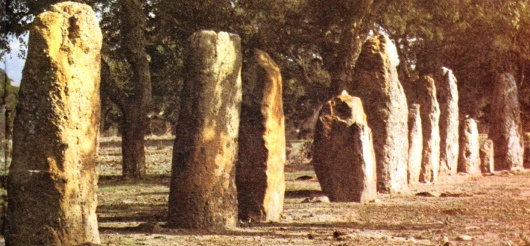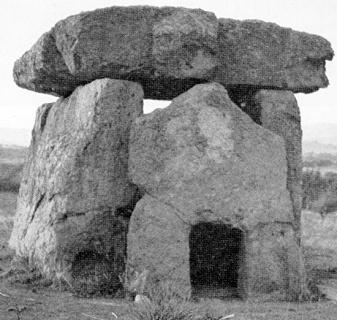THE COPPER AGE
Burial circles
Near Arzachena (SS) they have been recovered about fifty burial circles, composed by vertically erected stones, with inside some parallelepipedal urns, built with rectangular stone slabs, with burial functions. The most important complex, at Li Muri, consists of some circles with a diameter about from 5 to 8,7 mts.; 75% of they are oriented towards south. Outside of the complex it exists an isolated menhir with three concavities. On July 2000, the writer has characterized others three menhirs inside of the complex; two are both aligned with one lateral slab of one of the tombs oriented towards south; the other lateral slab of the same one tomb is aligned with a third menhir, always in direction south. The more outside menhir, of the first two, is also aligned with the lateral slabs of the two others tombs in direction west, with azimut 280-285°.
Also in the narrowness of their proportions, the “circles” of Arzachena find replies in the Anglo-Saxon circulars tumults of neolithic age (see Windmill Hill, England) and could introduce analogous stellar bearings.
Lonely menhirs, rows and cromlechs
In the Copper Age, also in Sardinia, like in continental Europe and the nearest Corsica, they come erected the so-called “menhirs”: single stones, remarkably heights, often gigantics. Until 1981 they had been taken a census of 250 menhir examples, an at least third party of which around Nuoro. High from 1 to 6,50 ms. (medium 3 meters), great part of Sardinian menhirs are carved with anthropomorph feminine simulations, a tipology found also in European within. It’s strongly hypothetical an astronomical bearing.

Goni (NU), astronomical bearing
Near Goni (NU), approximately sixty menhirs compose a “row” (a row of stones, also great dimensioned, aligned in an only direction); we have not still given in order to express with approximate certainty their eventual alignment towards astronomical directions. To Oliena/NU, near a village of 2000 b.C. it has been replaced in light a sanctuary in cyclopean technique 53x56 mts. long, residually 6 mts. height. Outside this sanctuary they have been recovered four semicircled in distant of 2,70 mts. menhirs. Based on such data it has been possible to assume the equidistant existence of a total circle constituted from 36 menhirs, forming a calendar “cromlech” (a breton expression indicating a circle formed by stone blocks that encircle a tumult from the shape to peristyle) of 36 decanic weeks, calculated in order to conciliate lunar (13 lunations/year) and solar compute (360 days/year). Fifth menhir still in situ, of a different stone regarding the other four ones, seems oriented towards the winter solstice.
An other megalithic circle (“Is Cirquittus”) constituted from seven great stones distributed on an approximately 50 meters of diameter ring has been recovered near Laconi (NU). Helding account of the values reported to the 2500 b.C., Pino Calledda and Giorgio Murru have found a disposition of stones towards the dawn at the summer solstice and towards the sunset at the winter solstice.
Dolmens
An other type of interment, classic of the European megalithism, in the same time it appears: “dolmens”, formed from vertical stones, not squared, than support one vertical, wide and one relatively flat slab; all usually covered of earth or stones.
Characteristic of Northern and North-east Sardinia, they have been identified, until 1967, approximately 50 examples of dolmens. Their structure finds partially replies in examples lightly more ancient of near Southern Corsica and, with the original cover of ground material, he seems similar to that one of the burial linear tumults or British Islands barrows. The scholars Edoardo Proverbio and Pino Calledda, in 1995, have observed dolmen Sa Coveccada (about 2500 b.C.) at Mores, and they have measured its azimut 123,8°; that is substantially the azimut of the the solstice winter sunrise. The other measurements about Sardinian dolmens, carried out from the two scholars have not given equally sure answers, save the generic consideration that approximately 85% of the examined dolmens are oriented towards south and south-east to you. It would be, however, to deepen the azimut of 173° approximately found in 3 dolmens over 18, and that is Dolmen Ladas at Luras (SS), Lu Parisi at Luogosanto (SS) and Su Laccu at Buddusò (NU).

Dolmen Sa Coveccada
In examining the analogous structures of Southern Corsica, the two scholars have supplied more precise hypotheses about the bearing of this last, and, taking in consideration beyond to the azimut, also the declination associated at the orientation of the dolmen, they has attributed their prevalent stellar target. Who writes has allowed itself to elaborate a relative table to such surveys, deducing them from how much the authors adfirm in “Rivista Italiana di archeoastronomia”, Rome 2004.
Astral correspondences of the alignments of the dolmen of Southern Corsica
|
Name |
Site |
Bearing |
Azimut |
Declination |
Astral alignments |
1 |
Renaggiu |
Sartene |
1500 b.C. |
90 |
- 0°,4 |
Betelgeuse |
2 |
Fontanaccia |
Sartene |
1500-1800 |
128 |
- 25° |
Winter solstice sunrise |
3 |
.. |
Petretto Bicchisano |
1500 ab. |
137 |
- 21° |
Greater southern lunar solstice sunrise |
4 |
Ciutulaghia |
Appietto |
2300 b.C. |
147 |
- 39°,3 |
Alfa Centauri |
5 |
.. |
Olmeto |
2100 b.C. |
150 |
- 40°,3 |
Alfa Centauri |
6 |
Cruci I |
Levie |
1400 b.C. |
158 |
- 44°,6 |
Alfa Crucis |
7 |
Cardiccia |
Sartene |
2800 b.C. |
164 |
- 44°,6 |
Alfa Muscae |
8 |
Bizzicu Rosu |
Grossa |
2200 b.C. |
174 |
- 46°,4 |
Alfa Muscae |
9 |
M.te Rotondu |
Sota |
2500 b.C. |
198 |
- 45°,7 |
Alfa Muscae |
10 |
Cruci II |
Levie |
1800 b.C. |
205 |
- 43°,1 |
Alfa Crucis |
11 |
Arghiola |
Sartene |
2700 b.C. |
218 |
- 34°,1 |
Beta Crucis |
From the examination of the solutions indicated, moreover, some perplexities appear, about the approximately shiftings of 5-6° regarding the exact azimut of the solstice and the lunar solstice, and the target connected to the star Alpha Muscae, who does not seem to have had a particular visibility in the stellar sky of the Neolithic and copper age. The attempt of the two scholars to apply the same ones target to the Sardinian dolmens seems still little convincing, even if by now it cannot be more denied that the Southern Corsica and the Northern Sardinia, made part of an only same megalithic culture, in prenuragic age.
|



